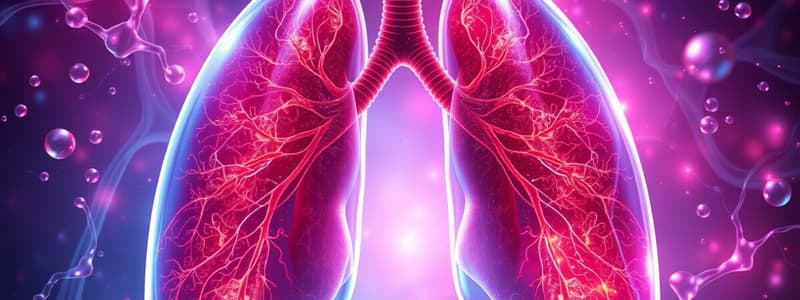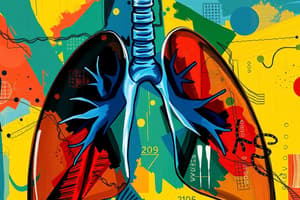Podcast
Questions and Answers
Which of the following is NOT considered a non-respiratory function of the lungs?
Which of the following is NOT considered a non-respiratory function of the lungs?
- Defense mechanisms of the respiratory system
- Metabolic functions
- Pulmonary fluid exchange
- Gas exchange (correct)
The removal and inactivation of hormones and toxins is part of the metabolic functions of the lungs.
The removal and inactivation of hormones and toxins is part of the metabolic functions of the lungs.
True (A)
Name one type of agent that the respiratory system's defense mechanisms protect against.
Name one type of agent that the respiratory system's defense mechanisms protect against.
Infectious agents
The lungs participate in pulmonary fluid exchange by producing ___ and pleural fluid.
The lungs participate in pulmonary fluid exchange by producing ___ and pleural fluid.
Match the lung functions with their descriptions:
Match the lung functions with their descriptions:
Which of the following is a characteristic of specific defenses in the immune system?
Which of the following is a characteristic of specific defenses in the immune system?
Nonspecific defenses include mechanisms such as the mucociliary system and cough reflex.
Nonspecific defenses include mechanisms such as the mucociliary system and cough reflex.
What type of immunity includes the presence of Toll-like receptors?
What type of immunity includes the presence of Toll-like receptors?
Specific defenses require several days to become activated and have ___ that protects against future attacks.
Specific defenses require several days to become activated and have ___ that protects against future attacks.
Match the following defense mechanisms with their descriptions:
Match the following defense mechanisms with their descriptions:
Flashcards are hidden until you start studying
Study Notes
Non-Respiratory Functions of the Lung
- Defense mechanisms protect the respiratory system against harmful substances.
- Common threats include organic dust, infectious agents, allergens, and various irritants.
Pulmonary Fluid Exchange
- Involves the production of lymph and pleural fluid.
- Essential for maintaining fluid balance in the thoracic cavity.
Metabolic Functions
- Facilitates removal and inactivation of hormones and toxins from the bloodstream.
- Supports platelet biogenesis, contributing to blood clotting processes.
Defense Mechanisms Overview
- Defense mechanisms are categorized into two primary types: nonspecific (innate) and specific (adaptive) defenses.
Nonspecific Defenses (Innate Immunity)
- Mucociliary System: A defense mechanism that traps and expels pathogens and particles through ciliary movement in the respiratory tract.
- Cough Reflex: A protective response that helps clear the airways of irritants and pathogens.
- Resident Phagocytic Cells: Cells located in alveoli that engulf and digest pathogens to prevent lung infections.
- Toll-like Receptors (TLRs): Proteins found on the surface of various cell types that recognize pathogens and initiate immune responses.
Specific Defenses (Adaptive Immunity)
- Targeted Response: Targets specific injurious agents rather than general threats.
- Activation Time: Takes several days for adaptive mechanisms to be fully activated upon the first encounter with a pathogen.
- Immune Memory: Capable of remembering past infections, allowing for faster and more effective responses to subsequent attacks by the same organism.
Studying That Suits You
Use AI to generate personalized quizzes and flashcards to suit your learning preferences.



